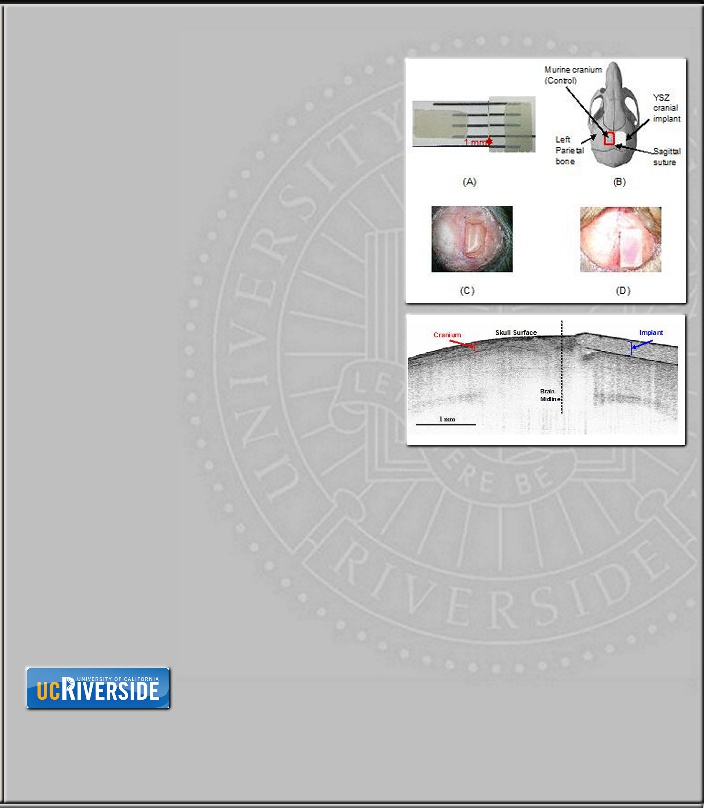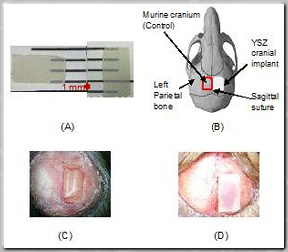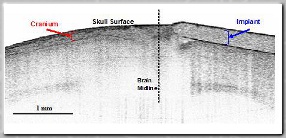












Copyright 2016 Biomedical Microdevices Laboratory
Current Research
Representative publications:
[1] Y Damestani, CL Reynolds, J Szu, MS Hsu, Y Kodera, DK Binder, BH Park, JE Garay, MP Rao, and G Aguilar. Nanomed-Nanotechnol 9(8):1135-1138, 2013.
[1] Y Damestani, CL Reynolds, J Szu, MS Hsu, Y Kodera, DK Binder, BH Park, JE Garay, MP Rao, and G Aguilar. Nanomed-Nanotechnol 9(8):1135-1138, 2013.
Top: Transparent nc-YSZ cranial
implants: A) Implant placed on printed
scale; B) Craniectomy location on murine
cranium; C) Craniectomy with dura mater
left intact; and D) After implant
placement. Note: Implant opacity in (D)
is flash-induced image artifact [1].
Bottom: OCT cross-sectional image of
murine brain through: (Left) Native
cranium; and (Right) nc-YSZ implant [1].
Windows to the Brain
Under the leadership of Prof. G Aguilar (UCR ME), research in this thrust focuses on developing novel transparent ceramic cranial implants, which may eventually provide a clinically-viable means for optically accessing the brain, on-demand, over large areas, and on a chronically-recurring basis, without need for repeated craniectomies.
While laser-based techniques have shown promise for enhancing the diagnosis and treatment of many neurological disorders, the poor transparency of cranial bone to clinically-relevant laser wavelengths typically necessitates use of invasive craniectomies to provide optical access to the brain. This constrains the ultimate utility of such techniques, particularly for applications where chronically-recurring access over large areas is required.
The nanocrystalline yttria-stabilized zirconia (nc-YSZ) implants shown here seek to address this limitation. Although these are not the first transparent cranial implants to be reported, they are the first that could be conceivably used in humans. This is due to the inherent toughness of YSZ, which makes it far more resistant to shock and impact than the glass-based implants previously demonstrated by others.
Collaborators:
G Aguilar, ME, UCR
JE Garay, ME, UCR
DK Binder, Biomed Sci & SoM, UCR
BH Park, BIEN, UCR
Under the leadership of Prof. G Aguilar (UCR ME), research in this thrust focuses on developing novel transparent ceramic cranial implants, which may eventually provide a clinically-viable means for optically accessing the brain, on-demand, over large areas, and on a chronically-recurring basis, without need for repeated craniectomies.
While laser-based techniques have shown promise for enhancing the diagnosis and treatment of many neurological disorders, the poor transparency of cranial bone to clinically-relevant laser wavelengths typically necessitates use of invasive craniectomies to provide optical access to the brain. This constrains the ultimate utility of such techniques, particularly for applications where chronically-recurring access over large areas is required.
The nanocrystalline yttria-stabilized zirconia (nc-YSZ) implants shown here seek to address this limitation. Although these are not the first transparent cranial implants to be reported, they are the first that could be conceivably used in humans. This is due to the inherent toughness of YSZ, which makes it far more resistant to shock and impact than the glass-based implants previously demonstrated by others.
Collaborators:
G Aguilar, ME, UCR
JE Garay, ME, UCR
DK Binder, Biomed Sci & SoM, UCR
BH Park, BIEN, UCR
Sponsors:
UCR Chancellor's Strategic Research Initiative (PI: Aguilar)
UCR Chancellor's Strategic Research Initiative (PI: Aguilar)
















